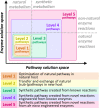Back to the future: Why we need enzymology to build a synthetic metabolism of the future
- PMID: 30873239
- PMCID: PMC6404388
- DOI: 10.3762/bjoc.15.49
Back to the future: Why we need enzymology to build a synthetic metabolism of the future
Abstract
Biology is turning from an analytical into a synthetic discipline. This is especially apparent in the field of metabolic engineering, where the concept of synthetic metabolism has been recently developed. Compared to classical metabolic engineering efforts, synthetic metabolism aims at creating novel metabolic networks in a rational fashion from bottom-up. However, while the theoretical design of synthetic metabolic networks has made tremendous progress, the actual realization of such synthetic pathways is still lacking behind. This is mostly because of our limitations in enzyme discovery and engineering to provide the parts required to build synthetic metabolism. Here I discuss the current challenges and limitations in synthetic metabolic engineering and elucidate how modern day enzymology can help to build a synthetic metabolism of the future.
Keywords: enzymes; in vitro biochemistry; metabolic engineering; synthetic biology.
Figures


Similar articles
-
Structural organization of biocatalytic systems: the next dimension of synthetic metabolism.Emerg Top Life Sci. 2019 Nov 11;3(5):579-586. doi: 10.1042/ETLS20190015. Emerg Top Life Sci. 2019. PMID: 33523157 Free PMC article.
-
Synthetic biology: an emerging engineering discipline.Annu Rev Biomed Eng. 2012;14:155-78. doi: 10.1146/annurev-bioeng-071811-150118. Epub 2012 May 7. Annu Rev Biomed Eng. 2012. PMID: 22577777 Review.
-
Opportunities for yeast metabolic engineering: Lessons from synthetic biology.Biotechnol J. 2011 Mar;6(3):262-76. doi: 10.1002/biot.201000308. Epub 2011 Feb 16. Biotechnol J. 2011. PMID: 21328545 Review.
-
Bottom-Up Synthesis of Artificial Cells: Recent Highlights and Future Challenges.Annu Rev Chem Biomol Eng. 2021 Jun 7;12:287-308. doi: 10.1146/annurev-chembioeng-092220-085918. Annu Rev Chem Biomol Eng. 2021. PMID: 34097845
-
Prospects and progress in the production of valuable carotenoids: Insights from metabolic engineering, synthetic biology, and computational approaches.J Biotechnol. 2018 Jan 20;266:89-101. doi: 10.1016/j.jbiotec.2017.12.010. Epub 2017 Dec 13. J Biotechnol. 2018. PMID: 29247672 Review.
Cited by
-
A pilot oral history of plant synthetic biology.Plant Physiol. 2024 Apr 30;195(1):36-47. doi: 10.1093/plphys/kiad585. Plant Physiol. 2024. PMID: 38163646 Free PMC article. Review.
-
Sensitive Oligodeoxynucleotide Synthesis Using Dim and Dmoc as Protecting Groups.J Org Chem. 2019 Nov 1;84(21):13374-13383. doi: 10.1021/acs.joc.9b01527. Epub 2019 Sep 27. J Org Chem. 2019. PMID: 31536351 Free PMC article.
-
In-Depth Computational Analysis of Natural and Artificial Carbon Fixation Pathways.Biodes Res. 2021 Aug 31;2021:9898316. doi: 10.34133/2021/9898316. eCollection 2021. Biodes Res. 2021. PMID: 37849946 Free PMC article.
-
Pickaxe: a Python library for the prediction of novel metabolic reactions.BMC Bioinformatics. 2023 Mar 22;24(1):106. doi: 10.1186/s12859-023-05149-8. BMC Bioinformatics. 2023. PMID: 36949401 Free PMC article.
-
Engineering Improved Photosynthesis in the Era of Synthetic Biology.Plant Commun. 2020 Feb 13;1(2):100032. doi: 10.1016/j.xplc.2020.100032. eCollection 2020 Mar 9. Plant Commun. 2020. PMID: 33367233 Free PMC article. Review.
References
-
- Jaffe B. Crucibles: The Story of Chemistry from Ancient Alchemy to Nuclear Fission. New York: Dover Publications; 1976.
-
- Wöhler F. Ann Phys (Berlin, Ger) 1828;88:253–256. doi: 10.1002/andp.18280870206. - DOI
-
- Asimov I A. Short History of Chemistry. Garden City, New York: Anchor Books; 1967.
Publication types
LinkOut - more resources
Full Text Sources
